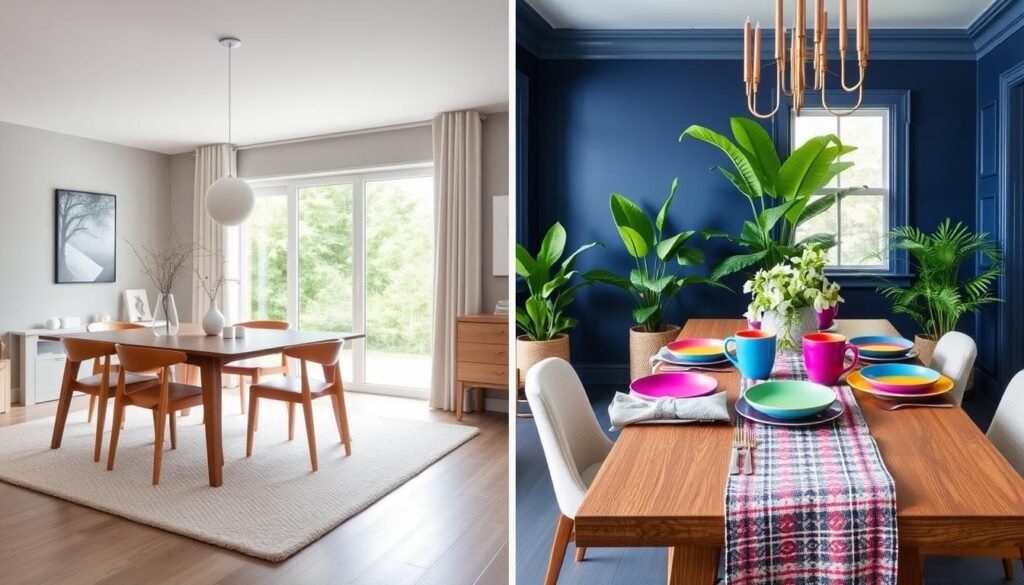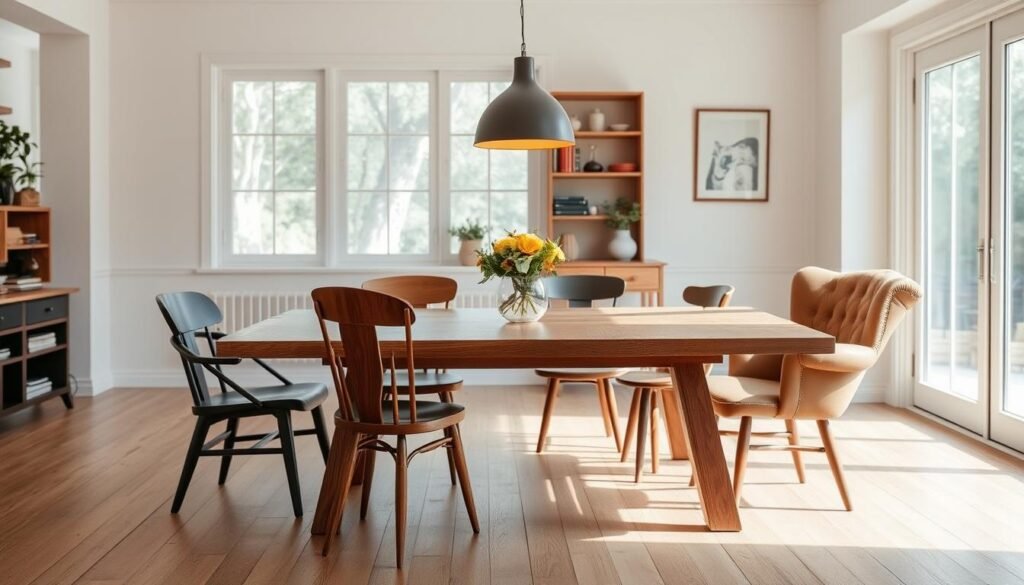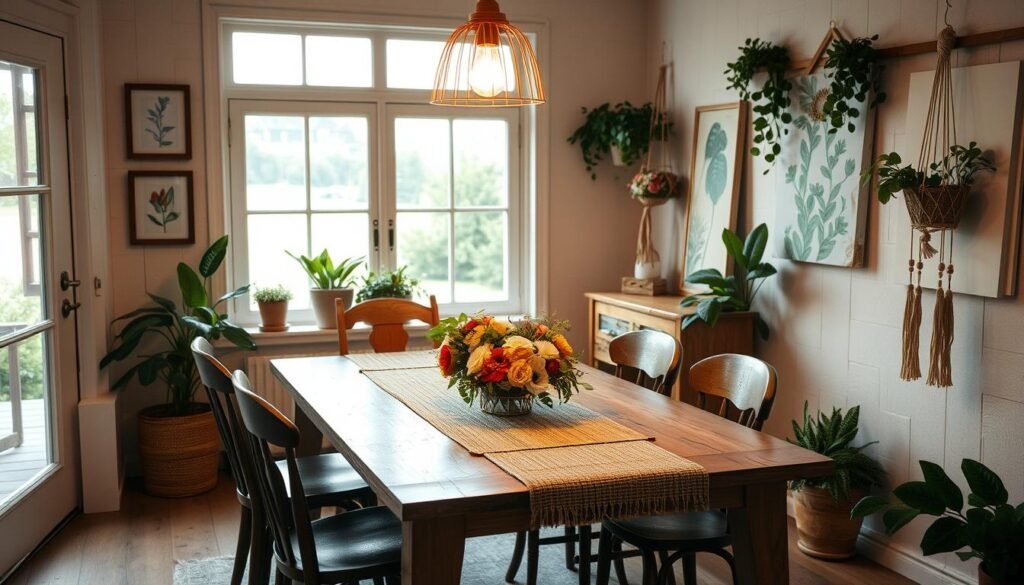Your dining area deserves to be more than just a spot for meals—it should feel like the heart of your home. Whether you’re hosting holiday dinners or enjoying casual weeknight meals, this guide helps you design a personalized space that balances style and practicality.
Creating a customized look doesn’t require a big budget. By embracing hands-on projects, you can transform ordinary items into standout features. Think painted thrift-store chairs or upcycled lighting fixtures—details that add character without breaking the bank.
What makes this approach special? You control every detail. Mix modern tableware with vintage linens. Turn inherited dishes into wall art. These choices make your space feel uniquely yours, blending memories with fresh ideas.
We’ll walk through smart planning tips, creative design hacks, and finishing touches that elevate your room. You’ll learn how to maximize natural light, arrange furniture for better flow, and choose colors that spark joy. Let’s turn your vision into reality!
Key Takeaways
- Personalize your gathering area to reflect your taste and lifestyle
- Save money through creative upcycling and budget-friendly projects
- Combine textures and eras for a layered, inviting atmosphere
- Optimize layouts for both daily use and special events
- Transform your space into a natural hub for connection
Introduction to DIY Dining Room Decor
Every home’s gathering spot tells a story—make yours unforgettable. Start by observing how sunlight dances across your table at different times or how guests naturally move through the area. These details become your blueprint for creating harmony between function and beauty.
Making Friends With Your Floor Plan
Measure twice, dream big. Note window placements that affect mood lighting and doorways that influence traffic flow. Architectural quirks like crown molding or alcoves can become focal points with the right attention. Your color choices should complement these existing features rather than fight them.
The Power of Personalized Projects
Ready-made solutions can’t match the satisfaction of custom creations. Want a chandelier that mirrors your grandmother’s heirlooms? Build it. Need storage that doubles as art? Design it. This hands-on approach lets you splurge on statement chairs while transforming affordable fabrics into curtains that wow.
| Factor | Hands-On Approach | Store-Bought Solution |
|---|---|---|
| Cost Efficiency | Repurpose existing items | Higher retail markup |
| Customization | Tailor to exact measurements | Limited size options |
| Timeline | Work at your rhythm | Dependent on deliveries |
| Personality | Embed personal history | Generic appearance |
Your gathering area should evolve as your life does. That bench you’re upholstering today might become tomorrow’s coffee nook. This flexibility keeps your space feeling fresh without constant overhauls.
Planning Your Dining Room Design Concept
Transforming your gathering area into a functional yet stylish hub begins with smart spatial strategies. Before diving into aesthetics, consider how people interact with the room’s dimensions and existing architectural features. A thoughtful layout ensures comfort during family dinners and lively celebrations alike.
Assessing Your Space and Layout
Start by measuring wall-to-wall distances and noting permanent fixtures like windows or doors. Aim for 30-36 inches of walkway space around furniture—this allows chairs to slide out smoothly without bumping into walls. For smaller areas, 24 inches works temporarily but can feel cramped when hosting.
Think about how the room connects to neighboring zones. An open-concept layout might benefit from matching floor materials, while separated spaces could use color continuity. Always test table sizes with painter’s tape on the floor—it reveals how much breathing room remains after adding chairs.
Setting a Clear Design Vision
Collect inspiration photos that spark joy, whether it’s a rustic farmhouse table or sleek modern lighting. Decide if you prefer casual mismatched chairs or uniform seating for a polished look. Your color scheme should complement adjacent rooms while reflecting the mood you want to cultivate.
Plan seating for your typical guest count plus two extra spots. Bench seating saves space for daily meals, while extendable tables accommodate holiday crowds. This balance ensures your design works as hard as you do—for both PB&J lunches and three-course dinners.
Selecting the Perfect Dining Room Furniture
The right furniture transforms meals into memories. Start by matching your table size to your lifestyle—oversized pieces overwhelm small spaces, while cramped setups frustrate guests. Use these guidelines to find your sweet spot:
Choosing Tables and Chairs
A 48-inch table seats four comfortably—ideal for cozy breakfasts. Need room for six? Stretch to 60-72 inches. Larger gatherings (8-12 people) require tables over 80 inches. Round shapes work magic in tight areas: a 42-inch diameter fits four, while 60 inches handles dinner parties.
Mix chair styles to balance budget and comfort. Invest in plush armchairs for the table ends, then pair with simpler side seats. Pro tip: Ensure chairs with arms tuck completely under the table—this keeps walkways clear when not in use.
Mixing Modern and Vintage Pieces
Pair a sleek glass table with weathered wooden chairs for instant character. Or flip the script: try a rustic farmhouse table with acrylic seats. This blend prevents that “showroom perfect” look while letting you showcase heirloom pieces.
Durability matters. Choose scratch-resistant surfaces for daily use tables. For chairs, consider wipeable fabrics if kids join meals often. Your furniture should age gracefully, telling stories through every scratch and patina.
DIY Dining Room Decor Projects for a Personalized Touch
Ordinary objects become extraordinary when infused with creativity. Start by assessing what you already own—that outdated sideboard or mismatched chairs could become showstoppers with simple transformations. The key? Focus on projects that amplify your style while keeping costs low.
Creative Upcycling and Customization
Turn forgotten furniture into conversation starters. A fresh coat of paint revitalizes tired chairs—try pairing sage green with burnt orange for a modern twist. For tables, stenciled patterns add flair without permanent changes. Pro tip: Use chalk paint for easy distressing effects that hide wear-and-tear.
Lighting upgrades make dramatic impacts. Rewire thrifted fixtures with bold-colored cords or add bead accents to plain lampshades. These tweaks create custom looks while preserving functionality. Even basic shelves gain character when lined with vintage wallpaper remnants.
Incorporating Bold Color Accents
Test daring hues through temporary changes. Swap neutral seat cushions for jewel-toned velvet covers during holidays. Paint just the inside of glass cabinets with raspberry tones for surprise pops of color. This approach lets you experiment risk-free.
- Layer patterned runners over solid tablecloths
- Frame children’s artwork as rotating wall displays
- Use removable decals on plain dishware
Remember: Your space should evolve with your tastes. That bright yellow bench today might become a muted teal treasure next year. Flexibility keeps your design feeling fresh and authentically you.
Incorporating Lighting and Fixtures to Enhance Ambiance
Ambient lighting isn’t just practical—it’s the secret ingredient to a welcoming atmosphere. When chosen thoughtfully, fixtures become functional art that shapes how spaces feel and function.
Finding Your Fixture’s Sweet Spot
Scale matters most when selecting overhead lighting. Your chandelier should measure half to three-quarters of your table‘s width. A 48-inch surface pairs best with 24-36 inch fixtures. Hang it 30-36 inches above the tabletop—this golden range prevents bumped heads while keeping light focused where needed.
Layered Lighting Strategies
Wall sconces add warmth without clutter. Install them 5-6 feet high, spacing 2-3 feet apart for balanced glow. Pair with dimmers to shift from bright homework lighting to soft dinner party ambiance. Pro tip: Use lower-wattage bulbs in secondary fixtures to maintain your chandelier as the star.
Mix materials for visual interest—try a woven rattan pendant over wood furniture or metallic sconces near textured walls. These combinations create depth while letting each piece shine. Remember: lighting should adapt to your life, not the other way around.
Exploring Color Schemes: Neutrals vs. Bold Hues
Color choices set the mood before the first bite is served. Whether you crave serene simplicity or vibrant energy, your palette shapes how guests feel. Let’s compare two winning strategies: timeless neutrals and daring accents that spark joy.

Soothing Neutrals for a Calm Setting
Off-white walls paired with minimalist furniture create airy, relaxed spaces. These soft backdrops let architectural details shine while encouraging meaningful conversation. Pro tip: Layer warm grays and creamy beiges for depth without visual noise.
Neutral bases offer flexibility. Swap burnt orange napkins for icy blue placemats as seasons change—no repainting required. This approach works beautifully in open-concept homes where colors need to flow between areas.
Embracing Unexpected Accent Colors
Dunn-Edwards’ Raspberry Patch proves bold risks pay off. This magenta tone adds drama without overwhelming smaller spaces when balanced with crisp white trim. Introduce vivid hues through removable elements first—like chartreuse chair cushions or abstract wall art.
Color psychology plays a key role. Sunny yellows energize morning coffee routines, while deep navy tones foster evening relaxation. Test samples at different times to see how light alters their effect.
Functional Decor: Balancing Style and Storage
Smart storage solutions turn cluttered corners into curated displays. By blending practicality with design flair, you maintain an organized environment that welcomes spontaneous gatherings and planned celebrations alike.
Space-Saving Strategies That Shine
Credenzas positioned at table height create visual harmony while hiding serving platters and linens. For taller ceilings, install floor-to-ceiling shelves with a rolling ladder—this vertical approach keeps holiday dishes accessible yet out of sight.
Consider these clever additions:
- Benches with lift-up seats for stashing board games or extra tablecloths
- Wall-mounted shelves displaying heirloom pitchers beside everyday napkin rings
- Ottomans with hollow interiors for tucking away children’s art supplies
Multi-functional furniture works overtime in compact areas. Expandable tables with built-in leaf storage adapt to different group sizes, while narrow console tables behind seating provide surface space without crowding walkways.
| Solution | Function | Style Benefit |
|---|---|---|
| Floating shelves | Hold serving trays | Showcase decorative bowls |
| Storage bench | Seats 3-4 guests | Conceals cleaning supplies |
| Glass-front cabinet | Protects fine china | Creates depth with reflection |
Keep often-used items in easy reach through strategic organization. Dedicate a drawer for placemats near the table, or hang frequently used utensils on wall hooks. This thoughtful approach maintains both accessibility and aesthetic appeal.
Mixing Modern and Vintage Elements for Character
The magic happens when centuries collide in your gathering space. Blending eras creates depth that store-bought sets can’t match—think of it as curating a museum where every piece tells its own story.

Start with your largest furniture piece. A streamlined table with clean lines becomes the perfect canvas for mismatched chairs from different decades. This contrast adds energy while keeping the look intentional rather than chaotic.
Seamless Style Integration Tactics
Find common ground through color or material. Paint all wooden chair legs the same walnut stain as your contemporary table base. Or pair mid-century metal chairs with a glass-top surface—the shared metallic tones create harmony.
“Good design isn’t about matching dates—it’s about matching energies.”
Scale matters when mixing periods. Balance a hefty farmhouse bench with slender acrylic side seats. This prevents any single era from dominating the space. Add texture through layered elements: drape an heirloom quilt over one chair back, then repeat its rust color in modern ceramic vases.
Your grandmother’s china cabinet gains new life when styled with geometric-patterned dishes. These thoughtful combinations make every meal feel both nostalgic and fresh—the true hallmark of timeless dining spaces.
Adding Texture and Patterns for Visual Interest
Texture and pattern transform ordinary spaces into visual stories waiting to be told. These elements add depth while guiding the eye through your gathering spot. Start by considering how different surfaces interact—smooth walls against rough fabrics, glossy ceramics beside matte metals.
Using Wainscoting, Wallpaper, and Rugs
Wainscoting instantly elevates sophistication with clean lines and tactile appeal. Pair it with bold wallpaper above the chair rail for contrast—interior designer Liz Goldberg recommends geometric prints that energize without overwhelming. This combination frames your dining room like a curated art gallery.
Rugs anchor the space but require thoughtful selection. An 8×10 flatweave accommodates chair movement and hides crumbs better than plush alternatives. Checkerboard patterns add playful energy, especially when colors echo nearby furnishings. Remember: leave 18-24 inches of floor visible around edges for balanced proportions.
Integrating Pattern Play with Furniture
Mix prints through removable elements first. Try striped seat cushions against floral curtains, united by shared accent hues. Vary scales—large-scale wallpaper pairs well with petite chair patterns. This approach prevents visual chaos while showcasing personality.
Layer materials for tactile richness. Combine a sleek glass table with woven placemats and hammered metal vases. These contrasts make every meal feel special yet approachable. Your room becomes a canvas where every texture tells part of your story.
Creating a Cozy and Inviting Ambiance
The true magic of a gathering space lies in how it makes people feel—welcome, relaxed, and eager to linger. Start by choosing seating that invites conversation long after plates are cleared. Slipcovered options, like those in Bungalow 10 Interiors’ design, blend comfort with casual elegance while hiding wear-and-tear.
Enhancing Comfort With Soft Furnishings
Plush cushions transform basic chairs into cloud-like perches. Opt for machine-washable fabrics in rich textures like velvet or linen—these handle spills gracefully while adding tactile warmth. Layer a neutral rug underfoot to soften footsteps and absorb sound during lively dinners.
Drape lightweight throws over bench seating for chilly evenings. Mix patterns through napkins or table runners, keeping colors cohesive for a pulled-together look. These touches create an environment where guests naturally unwind, turning quick meals into memorable moments.
Lighting plays a final supporting role. Dimmable fixtures cast a flattering glow, while candlelight adds flickering charm. Together, these elements craft spaces that nourish both body and connection.

